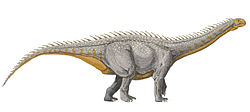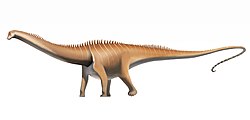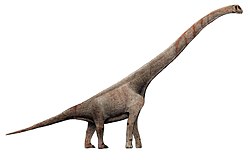| Uberabatitan Temporal range: Late Cretaceous, | |
|---|---|
 | |
| Holotype caudal vertebrae of Uberabatitan | |
| Scientific classification | |
| Kingdom: | Animalia |
| Phylum: | Chordata |
| Class: | Reptilia |
| Clade: | Dinosauria |
| Clade: | Saurischia |
| Clade: | † Sauropodomorpha |
| Clade: | † Sauropoda |
| Clade: | † Macronaria |
| Clade: | † Titanosauria |
| Clade: | † Lithostrotia |
| Genus: | † Uberabatitan Salgado and Carvalho, 2008 |
| Type species | |
| †Uberabatitan ribeiroi Salgado and Carvalho, 2008 | |
Uberabatitan (meaning "Uberaba titan", in reference to where it was found) is a genus of titanosaurian sauropod dinosaur from the Late Cretaceous of Brazil. It is known from bones including neck, back, and tail vertebrae, pelvic bones, and limb bones. These fossils were found in the uppermost portion of the Maastrichtian-age Serra da Galga Formation of the Bauru Group, in Uberaba, Minas Gerais. The type species, described by Salgado and Carvalho in 2008, is U. ribeiroi. To date, it is the most recent titanosaur from Bauru Group rocks; other titanosaurs from the Bauru Group, including Baurutitan and Trigonosaurus , come from lower (thus older) levels. [1]












